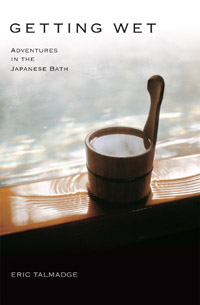Getting Wet: Adventures in the Japanese Bath by Eric Talmadge (Kodansha)
From Tokyo, Ernie Hoyt examines Eric Talmadge's plunges into different forms of the Japanese bath.
<br In 1981, Eric Talmadge set off for an adventure to the Land of the Rising Sun, not knowing that he would live there for the next twenty- plus years. While working for the Associated Press in Japan, he was assigned to cover the 1998 Nagano Winter Olympics, held in a place famous for its hot springs and giving Talmadge the brilliant idea of writing about Japan's onsen (hot springs).
In Japan, bathing is serious business. Hot springs are everywhere, from Hokkaido to Kyushu, and there are hundreds, if not thousands, of sento (public bath houses). But this book isn't a guide to the best hot springs or the cheapest sento. It’s one man's immersion into Japanese culture to find out why the Japanese are so obsessed with taking a bath.
The first spot Talamadge visits is Ikaho, a small town whose livelihood depends on its hot springs. In Japan, there is a law governing the use of the term onsen. The waters must be natural and must be at a certain temperature. Although Ikaho had been a popular hot spring destination for many years, in 2004 the town’s main attraction received some unwanted attention.
News broke that a lot of the ryokans (Japanese inns) were not properly maintained. A few places were topping off their baths with tap water or adding mixtures to make the baths look as if they contained more minerals than advertised. This was shocking news to the public at large, and the uproar closed down at least three of Ikaho’s inns. But the uproar became only a minor burp with Ikaho still a popular ryokan destination.
Aside from the meals served at a ryokan, a popular feature is the rotenburo - the outdoor bath. Before the arrival of Western modesty, most of these were communal—there are still some communal baths out in the country. But don't expect to be dazzled by young babes in the buff. The users are usually older women.
A ryokan isn’t the only place to enjoy an outdoor bath, Talmadge discovers on the sparsely populated island of Shikine, a part of Tokyo that is an eleven-hour ferry trip from the mainland. Shikine’s special hot springs are carbonated pools of iron sulfide. Their touted medical benefits may be questionable but they are definitely relaxing. However a dip in one of these sulfide pools may ensure a ripe odor for the next couple of days.
For those who feel they cannot afford to stay at a hot spring or find that the ryokans are a little out of the way, there’s a traditional Japanese bath that won’t cost as much but that may take a little courage to experience – the sento.
This is the public bathhouse, a vanishing feature in Japan, like drive-in movies in America. While not a spot that treats patrons like royalty, it’s quite relaxing.
Shy people can enjoy the sento experience by going to a super-sento – a public bath theme park—where communal areas require a swimsuit. Bathers can choose a milk bath, a sake bath, a rose water bath or a bath that will take them back to the days of the samurai.
The onsen can be recreated at home with bath products called “Japan’s Famous Hot Springs” which will turn any bathtub into the mineral waters of Beppu, Izu or other popular resorts. So instead of taking a quick shower, lie back in the tub for an onsen experience and let all the daily troubles drain away.
